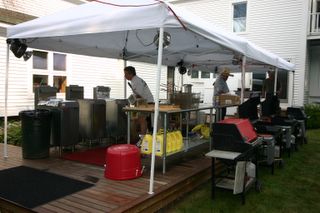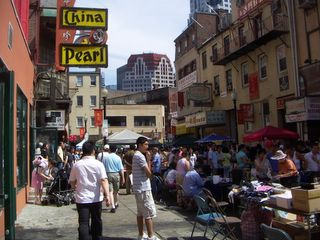Got back from another two weeks in Boston. From May through August, I have been on three separate trips to Boston: my former boss/mentor's birthday, road trip to Air Force Guy's wedding, and this trip to 'Summer Camp.' Counting vacation trips to Alaska, New York, and the Bay Area, I have been out travelling (for fun) for about 50 days. Man, I'm a slacker--over a third of the summer doing no research. Then again, this 'being a student during the summer' thing is rather novel after spending eight years in the working world.
There were some great highlights at the
summer camp festivities--this probably stems from the fact that my former boss/mentor is one of those guys who knows everybody, so lots of people either end up owing him favors, or want to do something as a contribution to the party. One example was the Cuban cigar makers--they brought a few suitcases of Dominican (?) tobacco, and set up a table to roll cigars for the crowd. Supposedly, their next gig was to be a party at George Sr.'s ranch.
Watching the Texans make barbecue was spectacular: my former boss bought a smoker and had it shipped up, and it gets rolled out once a year for this gig. The Texans are builders who, as a hobby, go on the competition barbecue circuit. They took a stack of boxes of meat taller than me, slathered it with brown sugar and spices while wearing rubber kitchen gloves, and let it smoke all day.

You will note the racks of ribs on the lower level, as well as several chickens with beer cans up their butts, for a vertical cooking position and flavor (hey, they came out pretty well).
We also had four or five 'normal size' gas grills going at the same time--I thought it was a good comparison of the 'massively parallel' grilling strategy and 'superbarbecuing'.

Of course, I used this trip to Boston to see the local folks, including drinks on the back porch at the Roost, a combined birthday party (for U5, Morton, and me) at Amie and Guy's place in Watertown, and dim sum at
China Pearl. Turns out that Chinatown was packed--I happened to pick August 7th, the celebration of the
August Moon Festival (a harvest festival). Chinese opera on one street, karaoke and DJs on another, and street vendor stalls packed tight. Pretty awesome.

I love coming to Boston (among other reasons) because of the random meetings. I ended up running into two sets of people on the street--completely randomly--while walking around Cambridge and Somerville. It resulted in some confusion: thought processes like, "Oh, it's Bats." -> "Wait, it's Bats--he doesn't live here!" -> "Oh yeah, Bats said he would be in town." Basically, I filled up my whole trip with a lunch here, a dinner there--a bit of time with a lot of friends--kinda like the way the mob skims the 'take' from the Vegas casinos.
Also, I got to do two 'house consulting' gigs for friends who have just bought places. I always consider that fun; I enjoy distributing appropriate knowledge to my geeky friends who are more likely to understand it and act on it. This included a trip to Bird and
Jen's mando (mansion divided into condominiums) in Dover, NH. It is huge, and the renovators did a pretty nice job of keeping the character intact. The living room is enormous: I was thinking of putting together a list of activities for the room (e.g., half court basketball games, competition ballroom dancing, crock opera revival performances). The basement is a bit scary (radon, moisture), but is fixable. After the tour, the group of us went to have dinner and hang out in Portsmouth, NH.

So overall, it was a great time in Boston. A great big thank you to everyone who took the time to see me, and another big thank you to those who offered their hospitality while I was in town.











